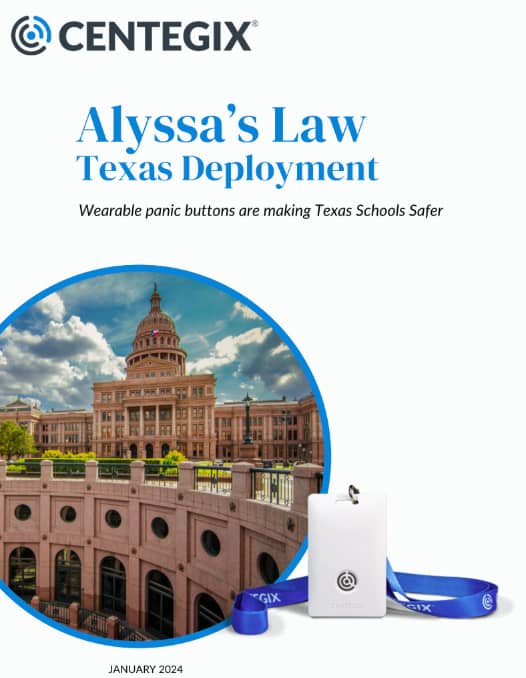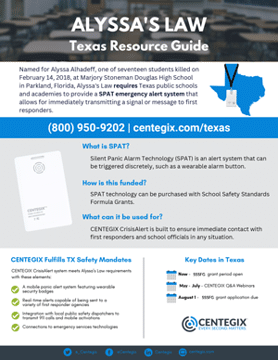CENTEGIX | Education
Texas School Safety Standards
CENTEGIX | Education
Texas School Safety Standards
CENTEGIX | Safety Report
Alyssa’s Law: Texas Deployment
Following the tragedy in Uvalde, parents, teachers, school officials and lawmakers came together to find practical solutions to protect our schools—including Alyssa’s Law.
To assist school districts in complying with new security requirements, we’ve compiled data from across the state into a report on school safety in Texas. This report provides valuable insight into key topics including: the most frequent incident alert locations, the different types of emergencies reported on campuses and adoption rates among staff.
Download the report today →
"*" indicates required fields
Texas Passes Alyssa’s Law
Texas took a major step to secure our schools by passing Alyssa’s Law, critical legislation that will bring panic alarm technology into every school across the state. If you aren’t familiar with Alyssa’s Law, we can help.
What do I need to know about Alyssa’s Law?
- Championed for years by Representative Shawn Thierry (D-Houston) and brought to the Senate by Brandon Creighton (R-Conroe), this bipartisan legislation aims to enhance school safety by requiring schools to install panic alarms that notify law enforcement during emergencies.
- Alyssa’s Law was passed by both the Texas House and Senate, sending the bill to Governor Abbott’s desk.
- When signed into law, Texas schools will have until the start of the 2025-2026 school year to install qualified panic alarm systems.
Is there funding available for Silent Panic Alarm Technology (SPAT)?
Yes. The School Safety Formula Grant, which is administered by the Texas Education Agency (TEA), can provide funding for school districts to purchase and install panic alarms, among other safety measures.
Does the School Safety Formula Grant cover CENTEGIX’s CrisisAlert?
Yes. CrisisAlert exceeds both TEA and Alyssa’s Law standards, provides total campus coverage and offers easy-to-use wearable panic buttons for all school staff, not just teachers.
When is the deadline for the School Safety Formula Grant?
The deadline for the grant application is August 1st.
How can you learn more about Panic Alert Technology or Alyssa’s Law?
Check out our free Texas Alyssa’s Law Resource Guide for more information on Alyssa’s Law in Texas and important dates and deadlines for implementation.
CENTEGIX Webinars
Leveraging Safety to Improve Teacher Retention and Recruitment | March 2024
Harm Mitigation: Keeping Your Staff Safe | March 2024
School Emergency Response: A Police Chief’s Perspective | April 2024
School Safety: Keep It Easy | April 2024
Texas Ahead of the Curve with New Bill: Texas HB3
Texas HB3 ushers in a historic increase in funding for Texas schools, but with this bill come some changes. How can you make sure you comply with this new law?
How Do You Evaluate Silent Panic Alert Technology (SPAT)?



To be effective, Silent Panic Alert Technology (SPAT) must have 100% user adoption, be simple and easy to use, and be specific on incident location. To evaluate if a solution will be the right fit for your district, ask these four questions:
Will staff adopt and use the technology?
Staff Adoption is Critical, and Mobile Apps Have Low Adoption. Following the Parkland Florida school tragedy, two months after an emergency response phone app was made available for educators to download, only 16% of one Florida school district staff had it installed on their mobile phones. A Marjory Stoneman Douglas teacher stated, “My cellphone is my private property. But putting [the application] on my phone means now my phone is part of my work property. And having that responsibility to have your phone on you all the time can be problematic.”
When every staff member is equipped with the CrisisAlert badge, you eliminate the need for educators to download an emergency response app to their personal device and achieve 100% user adoption.
Does it rely on wi-fi or cellular to communicate?
Wi-fi and Cell Service in Schools can Be Spotty, Leaving Mobile Apps Vulnerable. In an emergency, every second matters. Mobile app-based emergency response solutions that rely on wi-fi or a cellular signal to alert first responders can cost valuable seconds in repsonse time when a reliable signal can’t be found.
With a CrisisAlert badge, a staff member can initiate an alert anywhere on campus without worrying about whether they’re connected to the school’s wi-fi or if they have a strong cell signal. With the push of a button, first responders are instantly alerted.
Does it provide precise incident location to first responders?
Precise Location Information Impacts Response Time, and Mobile Apps Fall Short. Knowing precisely where to go during a crisis is a crucial piece of information for first responders and can determine whether a life gets saved or not. Mobile apps simply can’t guarentee accurate room- and floor-level incident information during a crisis.
When an emergency happens and an alert is triggered with the CrisisAlert badge, first responders instantly receive precise location information of the incident, down to the precise floor level and room number. This allows those in distress to get the help they need as soon as possible.
Will it notify everyone on campus?
Campus-Wide Notifications Protect Everyone, and Mobile Apps Lack the Functionality. When there’s an emergency, campus-wide notification of the event is paramount to ensuring everyone can take the necessary steps to get to safety. Mobile apps lack the functionality to be able to alert an entire campus of an emergency, such as a lockdown, with visual and audio cues.
CrisisAlert uses visual strobes, digital messages, and automated intercom announcements to inform everyone of a campus-wide incident and the actions to take.
CENTEGIX Safety Report
2024 School Safety Trends: Saving Seconds Saves Lives
Discover our latest, comprehensive analysis of school safety incidents gathered from the CENTEGIX Safety Platform™ usage data for the 2023-2024 school year in our report 2024 School Safety Trends: Saving Seconds Saves Lives.
See what else our safety report reveals regarding safety in the classroom, state safety legislation, and critical components of school safety solutions. Download your copy today.

How Are Your Resources Being Spent?
CENTEGIX protects over 11,500 schools across the country. We can protect your school, too.
The CENTEGIX Safety Platform™, featuring CrisisAlert™, accelerates your response to emergencies. We’ve built the CENTEGIX Safety Platform to support you in the single most critical factor of incident response: time. Because in an emergency, every second matters.
Discover federal resources to fund new safety and security initiatives in your district by exploring federal funding resources for school safety.

Discover the Safety Platform
Safety solutions that prioritize speed for the best outcome.
Mapping and locating capabilities provide the precise location—of emergencies, visitors, and safety assets.
A visitor management system screens and locates visitors on your campus.
Protocol development to plan for rapid incident response.
Texas Education Agency School Safety Standards

The proposed school safety standards were released by TEA, and with the new requirements are significant grant allocations to offset the costs of improvements. The new standards address the findings in the Robb Elementary School preliminary investigative report that indicated an unsecured door and multiple communications challenges were factors in the tragedy at Uvalde. Learn more about the standards here.
2022-2024 Silent Panic Alert Technology (SPAT) Grant Overview and Requirements:
The purpose of the SPAT Grant is to provide grant funds to local educational agencies (LEAs) to purchase silent panic alert technologies for campuses as a measure of school safety.
Silent panic alert technology is generally defined as a silent system signal generated by the activation of a device, either manually or through software applications, intended to signal a life-threatening or emergency situation (such as an active shooter, intruder, or other emergency situation) requiring a response from law enforcement and/or other first responders. Learn more about the standards here.
2023-2025 School Safety Standards Formula Grant Overview and Requirements
This grant program will calculate formula allocations based on a per-pupil amount per LEA. Grant funds will be distributed by per-pupil counts that were derived from age 3-21 student enrollment as reported in the October 2021 PEIMS submission.
There will be a $200,000 grant allocation for smaller and rural LEAs, even if using the per-pupil methodology they would receive less than the $200,000 minimum grant award.
The grant will allow spending on a variety of security-related items identified by the needs of each LEA. The grant will allow for various costs associated with school safety and security; however, the grant will come with a requirement that money must first be spent on items necessary to comply with the rule.
Once the standards of the rule are met, remaining funds can be spent on other eligible security-related costs as defined in the grant program allowable costs.
CENTEGIX CrisisAlert vs. Mobile Apps
CrisisAlert eliminates vulnerabilities related to app-only solutions and enables rapid incident response to all emergencies.

In an Emergency, You Need CrisisAlert™
Adverse situations can happen at any moment—from everyday crises such as medical emergencies, severe weather, and physical altercations to extreme situations that threaten your entire campus. The faster you get help to the right location, the better the outcome.
See how our CrisisAlert wearable mobile panic button empowers staff to get help instantly in an emergency.
Ready to Connect with a CENTEGIX Specialist to Learn More?
"*" indicates required fields
*By providing my phone number to CENTEGIX, I agree and acknowledge that CENTEGIX may send text messages to my wireless phone number for any purpose. Message and data rates may apply. CENTEGIX will only send one SMS as a reply, and I will be able to Opt-out by replying “STOP”. **No mobile information will be shared with third parties/affiliates for marketing/promotional purposes.*

Empower Your Educators
with Safety
Explore More Safety Resources
The Impact of Building a Culture of Safety in Schools
Creating a safe and secure environment is of the utmost importance for schools. Safer environments ensure the well-being of students, teachers, and staff.
Improving Student and Staff Outcomes with Incident Response Technology
Medical emergencies can happen to anybody, anywhere. CENTEGIX’s school safety technology is there to protect everyone on campus, at all times.
2023 Safety Spring Trends Report
In this report, CENTEGIX offers its latest, comprehensive analysis of school safety incidents and staff survey feedback gathered from our CrisisAlert usage data for the 2023 spring term.
School Safety Standards by State
Schools in any state can meet school safety grant funding requirements by choosing CENTEGIX CrisisAlert™ solution.
SOLUTIONS
INDUSTRIES
RESOURCES
COMPANY
PARTNERS
CONTACT
EVERY. SECOND. MATTERS.®









